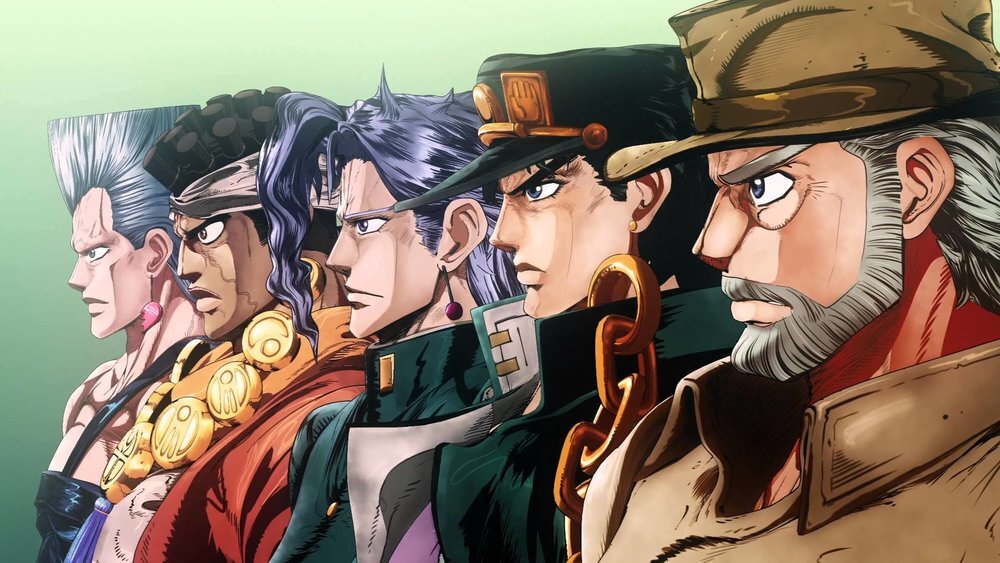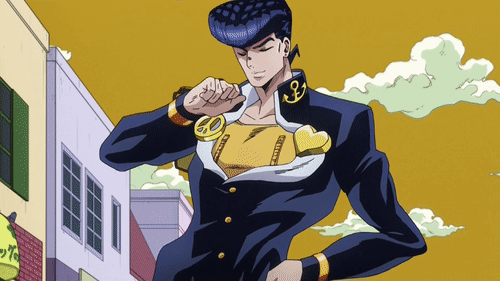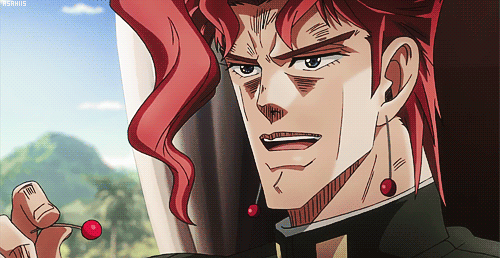I recently jumped into Jojo’s Bizarre Adventure, an anime I’ve heard about for a long time but had never given a chance. I knew two things about it going in.
First, it’s an action show in the tradition of Shonen Jump manga. Most episodes feature elaborate fights and lots of screaming and naming of one’s attacks. Secondly, I knew that the internet deemed many of the characters of Jojo’s Bizarre Adventure queer icons with audacious fashion taste. I had to watch it.
Jojo’s Bizarre Adventure does a few things very well, but it has a ways to go in a couple of areas. I’m going to break it down in this handy dandy list of things you need to know about, what else, Jojo’s Bizarre Adventure.
The story makes no sense, but works
I’d like to try and describe the plot of Jojo’s Bizarre Adventure, but I’m not sure how possible that is. The first season follows Jonathan Joestar, a British aristocrat, and his adopted brother Dio. Dio finds and wears an ancient mask that makes its user into a vampire, then Jonathan must defeat him using the power of Hamon, the mystical life energy some people can channel into superheroic powers. Yep. That’s the first arc in a nutshell.
From there, things only get stranger. The second arc features Jonathan’s grandson, Joseph, who has to travel to defeat the Pillar Men, beings closer to gods than humans. I think the second arc of Jojo’s Bizarre Adventure gets at what makes the show so great. As Joseph travels, he accumulates a cast of companions to help him on his journey. They all have different motivations for going after the Pillar Men, or accompanying Joseph, but their friendship makes the show special. It’s kind of like a long, buddy-buddy road trip in some respects.
Things get more complicated when the show introduces Stands and a new cast of characters in Stardust Crusaders, the third arc of the show. I’m not going to get into the plot, but I will talk a little about Stands, as they’re integral to what fans love about Jojo’s. Stands are, as I can best describe them, manifestations of a person’s psychic strength. People who use Stands mostly come by them naturally, although some later arcs discuss how people can have Stands forced upon them by supernatural means. This brings me to my next point, aesthetics.
POSE!
Aesthetics are everything
A huge part of Jojo’s Bizarre Adventure is the sheer look of the show. You can basically determine who’s a main character or enemy by what they wear. This is something that only gets more apparent as time goes on and Stands are introduced.
Stands are exaggerated, larger than life representations of a character. And they’re campy. SO CAMPY. Stands are colorful, big, and muscular (more so than the already-ripped characters). What’s the most interesting to me is that no one seems to comment on the appearance of Stands, only what they can do in battle. Does no one seriously notice how flamboyant and outrageous some Stands are? If they do, they don’t say anything about it. Stands might be key to battle in Jojo’s Bizarre Adventure, but they also show that the series isn’t afraid to go head to head with masculinity in an interesting way.
While many (most?) Jojo’s protagonists are absolutely jacked at the age of 16 or so, they aren’t strictly victims of hypermasculinity. Instead, characters pose, concern themselves with fashion, and form intense bonds with their friends. This isn’t to say that she show doesn’t portray masculinity in problematic ways (more on that later), but I think that Jojo’s Bizarre Adventure presents a different sort of masculinity than many other anime do, something more fluid. Most of the men of Jojo’s don’t feel the need to establish their masculinity, so they dress and act how they want. Some of the later seasons (which I haven’t quite gotten to yet) seem even more open to different versions of masculinity, which is exciting. We love to see camp in action.
Additionally, on a purely artistic level, each season of the show has different influences, which means that the color palette and art style gets a refresher periodically. By changing up the animation, Jojo’s manages to stay fresh and keep viewers guessing.
Shonen with a sense of humor
I grew up on Shonen anime and manga like Akira Toriyama’s Dragon Ball Z (my first introduction to anime) and Trigun. I loved shows that featured fights on fights on fights, and while many women my age have fond memories of shows marketed to girls, like Sailor Moon, I’m much more familiar with anime aimed at a 12 year old boy demographic. Now, as an adult I greatly prefer other types of anime. In fact, I hate most shows marketed to young boys now, and favor either grittier or girlier fare. Jojo’s Bizarre Adventure is the exact opposite of everything I normally like, but it’s bizarre sense of humor makes it different from other shows popular with boys.
It’s difficult to describe the humor in Jojo’s. In Stardust Crusaders, the team acquires a dog that farts on people when he gets mad or scared. There’s a scene where a character bounces a cherry on his tongue for an uncomfortable amount of time while saying, “lick lick lick.” Stands have stupid powers, like an additional face on the back of someone’s head. One stand user is an orangutan. My point is, you never know what’s going to happen in Jojo’s Bizarre Adventure because it’s all so overwhelmingly weird. I can never predict what’s going to happen, and I enjoy being surprised by the absolute absurdity of it all.
Lick lick lick lick lick
Weird treatment of women
Despite all the praise I’ve given Jojo’s Bizarre Adventure, there are things I don’t like. Nothing I dislike is enough to make me stop watching completely, but I do have to question it. The first thing that I noticed while watching Jojo’s was the poor treatment of women. In earlier arcs, which take place well in the past, it makes sense that women would be treated somewhat differently, but in more contemporary seasons, it hurts to see characters constantly behave as if women are helpless or stupid.
I think that the way Jojo’s treats women is more complicated than it seems at first. For example, Jotaro from Stardust Crusaders, who sticks around for several seasons of the show, seems like a raging misogynist. He talks to his mom disrespectfully, acts like women are incapable of taking care of themselves, and just seems to all around disrespect anyone who isn’t a jacked dude. However, as the arc moves on viewers come to realize that Jotaro loves his mom and is terrified of losing her. His disrespect covers up emotions he’s not ready to deal with yet as a teen boy (he might not look like a teen boy, but he definitely is). This sort of layered take isn’t true of everyone on the show. I’m pretty certain that Joseph Joestar is a womanizer through and through.
Animal death
If you see an animal on Jojo’s Bizarre Adventure, it will die. And I hate that.
Creative enemies
Part of the fun of episodic shows like Sailor Moon or Jojo’s Bizarre Adventure is that viewers get to see what villain will be the flavor of the week. Most of the time, there’s a new baddie every episode or two, with unique powers the team has to face. Combining what I said earlier about the show’s strange sense of humor and its special attention to aesthetics, I have to pay tribute to the enemies of the show, which are by far my favorite part.
Some of the enemies the team faces are downright terrifying. One grants wishes that quickly turn into nightmares. One has a Stand that takes the form of a gun and bullets. How scary is a gun that can never run out of ammo? While each Stand user has qualities that make them somewhat humorous, at the end of the day the variety of enemies that the characters encounter makes the show consistently interesting. If you don’t like an enemy, just wait a couple of episodes and there will be a new one for you to enjoy.
Overall, I’m on board with Jojo’s Bizarre Adventure, and I can’t wait for the adaptation of Stone Ocean, which will feature a woman as its main protagonist. That’s right, a woman Jojo. The world might not be ready.
Me waiting for Jolyne Kujo to appear.




